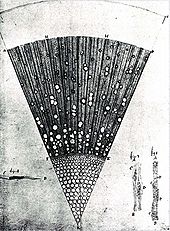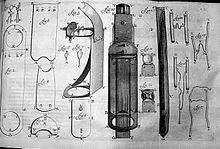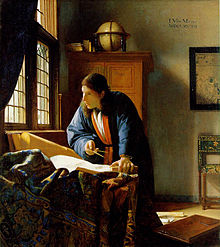Anton Van Leeuwenhoek
Antonie van Leeuwenhoek
| Antonie van Leeuwenhoek | |
|---|---|
 Portrait of Antonie van Leeuwenhoek (1632–1723) by Jan Verkolje |
|
| Born |
October 24, 1632 Delft, Netherlands |
| Died |
August 26, 1723 (aged 90) Delft, Netherlands |
| Residence | Netherlands |
| Nationality | Dutch |
| Fields | Microscopist and Biologist |
| Known for |
Discovery of protozoa First red blood cell description |
|
Signature |
|
Antonie Philips van Leeuwenhoek (in Dutch also Anthonie, Antoni, or Theunis, in English, Antony or Anton;[1] English pronunciation: /ˈleɪvənhʊk/,Dutch: [ˈleːʋənˌhuːk] (![]() listen); October 24, 1632 – August 26, 1723) was a Dutch tradesman and scientist from Delft, Netherlands. He is commonly known as "the Father of Microbiology", and considered to be the first microbiologist. He is best known for his work on the improvement of themicroscope and for his contributions towards the establishment of microbiology. Using his handcrafted microscopes, he was the first to observe and describe single-celled organisms, which he originally referred to as animalcules, and which we now refer to as micro-organisms. He was also the first to record microscopic observations of muscle fibers, bacteria, spermatozoa, and blood flow in capillaries (small blood vessels). Van Leeuwenhoek did not author any books, although he did write many letters.
listen); October 24, 1632 – August 26, 1723) was a Dutch tradesman and scientist from Delft, Netherlands. He is commonly known as "the Father of Microbiology", and considered to be the first microbiologist. He is best known for his work on the improvement of themicroscope and for his contributions towards the establishment of microbiology. Using his handcrafted microscopes, he was the first to observe and describe single-celled organisms, which he originally referred to as animalcules, and which we now refer to as micro-organisms. He was also the first to record microscopic observations of muscle fibers, bacteria, spermatozoa, and blood flow in capillaries (small blood vessels). Van Leeuwenhoek did not author any books, although he did write many letters.
Contents[hide] |
[edit]Early involvement with the microscope
Van Leeuwenhoek's interest in microscopes and a familiarity with glass processing led to one of the most significant, and simultaneously well-hidden, technical insights in the history of science. By placing the middle of a small rod of soda lime glass in a hot flame, Van Leeuwenhoek could pull the hot section apart to create two long whiskers of glass. Then, by reinserting the end of one whisker into the flame, he could create a very small, high-quality glass sphere. These spheres became the lenses of his microscopes, with the smallest spheres providing the highest magnifications. An experienced businessman, Leeuwenhoek realized that if his simple method for creating the critically important lens was revealed, the scientific community of his time would likely disregard or even forget his role in microscopy. He therefore allowed others to believe that he was laboriously spending most of his nights and free time grinding increasingly tiny lenses to use in microscopes, even though this belief conflicted both with his construction of hundreds of microscopes and his habit of building a new microscope whenever he chanced upon an interesting specimen that he wanted to preserve.
Van Leeuwenhoek used samples and measurements to estimate numbers of microorganisms in units of water.[2][3] Van Leeuwenhoek made good use of the huge lead provided by his method. He studied a broad range of microscopic phenomena, and shared the resulting observations freely with groups such as the English Royal Society.[4] Such work firmly established his place in history as one of the first and most important explorers of the microscopic world. He was one of the first people to discover cells, along with Robert Hooke.
[edit]Eventual recognition by the Royal Society of London
After developing his method for creating powerful lenses and applying them to study of the microscopic world, Van Leeuwenhoek was introduced via correspondence to the Royal Society of London by the famous Dutch Physician Reinier de Graaf. He soon began to send copies of his recorded microscopic observations to the Royal Society. In 1673, his earliest observations were published by the Royal Society in its journal: Philosophical Transactions. Amongst those published were Van Leeuwenhoek's accounts of bee mouthparts and stings.
Despite the initial success of Van Leeuwenhoek's relationship with the Royal Society, this relationship was soon severely strained. In 1676, his credibility was questioned when he sent the Royal Society a copy of his first observations of microscopic single-celled organisms. Previously, the existence of single-celled organisms was entirely unknown. Thus, even with his established reputation with the Royal Society as a reliable observer, his observations of microscopic life were initially met with skepticism. Eventually, in the face of Van Leeuwenhoek's insistence, the Royal Society arranged to send an English vicar, as well as a team of respected jurists and doctors, to Delft, to determine whether it was in fact Van Leeuwenhoek's ability to observe and reason clearly, or perhaps the Royal Society's theories of life itself that might require reform. Finally in 1680, Van Leeuwenhoek's observations were fully vindicated by the Society.
Van Leeuwenhoek's vindication resulted in his appointment as a Fellow of the Royal Society in that year. After his appointment to the Society, he wrote approximately 560 letters to the Society and other scientific institutions over a period of 50 years. These letters dealt with the subjects he had investigated. Even when dying, Van Leeuwenhoek kept sending letters full of observations to London. The last few also contained a precise description of his own illness. He suffered from a rare disease, an uncontrolled movement of the midriff, which is now named Van Leeuwenhoek's disease.[7] He died at the age of 90, on August 26, 1723 and was buried four days later in the Oude Kerk (Delft).
In 1981 the British microscopist Brian J. Ford found that Van Leeuwenhoek's original specimens had survived in the collections of the Royal Society of London.[8] They were found to be of high quality, and were all well preserved. Ford carried out observations with a range of microscopes, adding to our knowledge of Van Leeuwenhoek's work.
[edit]Discoveries
Van Leeuwenhoek ground more than 500 optical lenses. He also created at least 25 microscopes, of differing types, of which only nine survive. His microscopes were made of silver or copper frames, holding hand-ground lenses. Those that have survived are capable of magnification up to 275 times. It is suspected that Van Leeuwenhoek possessed some microscopes that could magnify up to 500 times. Although he has been widely regarded as a dilettante or amateur, his scientific research was of remarkably high quality.[9]
Van Leeuwenhoek's main discoveries are:
- the infusoria (protists in modern zoological classification), in 1674
- the bacteria, (e.g., large Selenomonads from the human mouth), in 1676
- the vacuole of the cell.
- the spermatozoa in 1677. Van Leeuwenhoek had troubles with Dutch theologists about his practice.
- the banded pattern of muscular fibers, in 1682.[10]
In 1687 he reported his research on the coffee bean. He roasted the bean, cut it into slices and saw a spongeous interior. The bean was pressed, and an oil appeared. He boiled the coffee with rain water twice, set it aside (and probably drank it slowly).[11]
He was visited by Leibniz, William III of Orange and his wife, the Amsterdam burgemeester (the mayor) Johan Huydecoper, the latter very interested in collecting and growing plants for the Hortus Botanicus Amsterdam and all gazed at the tiny creatures. Nicolaes Witsen sent him a map of Tartaria and amineral found near the origin of the river Amur.[12] In 1698 Van Leeuwenhoek was invited in the boat of tsar Peter the Great. On the occasion Van Leeuwenhoek presented the tsar an "eel-viewer", so Peter could study the blood circulation, whenever he wanted.
Like Robert Boyle and Nicolaas Hartsoeker, Van Leeuwenhoek was interested in the dried cochineal, trying to find out if the dye came from a berry or aninsect.[13][14][15]
[edit]Lenses secret
Van Leeuwenhoek maintained throughout his life that there are aspects of microscope construction "which I only keep for myself", in particular his most critical secret of how he created lenses. For many years no-one was able to reconstruct Van Leeuwenhoek's design techniques. However, in 1957 C.L. Stong used thin glass thread fusing instead of polishing, and successfully created some working samples of a Leeuwenhoek design microscope.[16] Such a method was also discovered independently by A.Mosolov and A.Belkin in the Novosibirsk State Medical Institute.[17]
[edit]Religious interpretations of his discoveries
Van Leeuwenhoek was a Dutch Reformed Calvinist.[18] He often referred with reverence to the wonders God designed in making creatures great and small. He believed that his amazing discoveries were merely further proof of the great wonder of God's creation.[19][20]
Van Leeuwenhoek's discovery that smaller organisms procreate similarly to larger organisms challenged the contemporary belief, generally held by the 17th-century scientific community, that such organisms generated spontaneously. The position of the Church on the exact nature of the spontaneous generation of smaller organisms was ambivalent.[citation needed]
[edit]Possible Vermeer connection
Van Leeuwenhoek was a contemporary of another famous Delft citizen, painter Johannes Vermeer, who was baptized just four days earlier. It has been suggested that he is the man portrayed in two of Vermeer's paintings of the late 1660s, The Astronomer and The Geographer. However, others argue that there appears to be little physical similarity. Because they were both relatively important men in a city with only 24,000 inhabitants, it is likely that they were at least acquaintances. Also, it is known that Van Leeuwenhoek acted as the executor of the will when the painter died in 1675.[21]
In A Short History of Nearly Everything (p. 236) Bill Bryson alludes to rumors that Vermeer's mastery of light and perspective came from use of a camera obscuraproduced by Van Leeuwenhoek. This is one of the examples of the controversial Hockney–Falco thesis, which claims that some of the Old Masters used optical aids to produce their masterpieces.
[edit]See also
[edit]Footnotes
- ^ Leeuwenhoek was christened as Thonis and always signed his name Antonij, which corresponds with Antony in modern English. His given name can also be found written as Anton, Anthon, Anthony, Antonie, Antony, Anthonie, Antoni, Antonio and Anthoni. Leeuwenhoek, believing that he was by then an established figure, added a van to his name in 1686. Seehttps://www.archief.delft.nl/
- ^ Egerton, F. N. 1967. Van Leeuwenhoek as a founder of animal demography. Journal of the History of Biology 1:1–22.
- ^ Frank N. Egerton (2006) A History of the Ecological Sciences, Part 19: Leeuwenhoek's Microscopic Natural History. Bulletin of the Ecological Society of America: Vol. 87, No. 1, pp. 47-58. doi:10.1890/0012-9623(2006)87[47:AHOTES]2.0.CO;2
- ^ "UCMP Hooke bio". Ucmp.berkeley.edu. Retrieved 2010-06-13.
- ^ https://lensonleeuwenhoek.net/biography.htm
- ^ Giants of Delft: Johannes Vermeer and the natural philosophers : the ... Door Robert D. Huerta [1]
- ^ Life and work of Antoni van Leeuwenhoek of Delft in Holland; 1632-1723 (1980) Published by the Municipal Archives Delft, p. 9
- ^ "The discovery by Brian J Ford of Leeuwenhoek's original specimens, from the dawn of microscopy in the 16th century". Brianjford.com. Retrieved 2010-06-13.
- ^ Ford, Brian J. (1992), From Dilettante to Diligent Experimenter: a Reappraisal of Leeuwenhoek as microscopist and investigator, Biology History, 5 (3), available at https://www.brianjford.com/a-avl01.htm
- ^ A disease in the city of Kampen, Netherlands (1736), which originated (caused) by "little animals". These 'bloedloze dieren' (bloodless animals, the Invertebrata) are — most likely — the little animals described in the work of Antonie van Leeuwenhoek (Evert Valk, a physician about an epidemic in the city of Kampen during the year 1736)
- ^ May, 9, 1687, Missive 54.
- ^ Driessen, J. (1996) Tsaar Peter de Grote en zijn Amsterdamse vrienden, p. 35, 95, 96.
- ^ The select works of Antony van Leeuwenhoek
- ^ https://www.strangescience.net/leeuwenhoek.htm
- ^ Greenfield, Amy Butler (2005). A Perfect Red: Empire, Espionage, and the Quest for the Color of Desire. New York: Harper Collins Press. ISBN 0-06-052276-3
- ^ "A glass-sphere microscope". Funsci.com. Retrieved 2010-06-13.
- ^ A.Mosolov; A.Bccccelkin (1980). "Secret of Antony van Leeuwenhoek?".Nauka i Zhizn (Science and Life) 09-1980: 80–2.
- ^ "The religious affiliation of Biologist A. van Leeuwenhoek". Adherents.com. 2005-07-08. Retrieved 2010-06-13.
- ^ "The Religion of Antony van Leeuwenhoek". 2006. Retrieved 2006-04-23.
- ^ A. Schierbeek, PhD, Editor-in-Chief of the Collected Letters of A. v. Leeuwenhoek, Formerly Lecturer in the History of Biology in the University of Leyden, Measuring the Invisible World: The Life and Works of Antoni van Leeuwenhoek F R S, Abelard-Schuman (London and New York, 1959), QH 31 L55 S3, LC 59-13233. This book (223 pp.) contains excerpts of Leeuwenhoek’s letters and focuses on his priority in several new branches of science, but makes several important references to his spiritual life and motivation.
- ^ Van Berkel, K. (February 24, 1996). Vermeer, Van Leeuwenhoek en De Astronoom. Vrij Nederland (Dutch magazine), p. 62–67.






